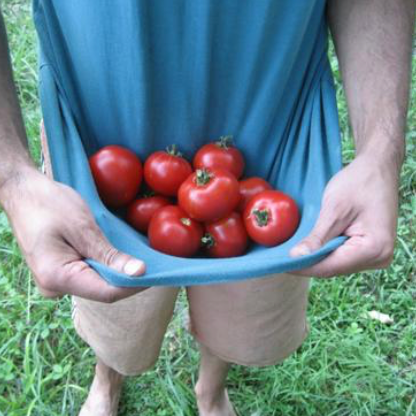 Rose de Berne Tomatoes
Rose de Berne TomatoesOur hot and fairly dry summer has had many effects on the garden, the most welcome of which is the imminent and seemingly strong tomato crop. What a marvelous counterpoint to last year's collective tomato sadness!
Many growers and gardeners have already started to harvest their earliest outdoor-grown fruits (those with hoophouses began a month ago--even a small greenhouse can achieve these early, delectable fruits!). Leading the pack are the ultra-early varieties and the cherry tomatoes. Soon, the early main season crops will ripen, and swiftly (knock on wood) we will all find ourselves afloat in a sea of tomato bounty.
Here are five thoughts on handling and extending the tomato harvest.
- Once the first fruits start to ripen, be sure to check your plants at least every two days. During exceptional hot and dry weather, a daily checkup is even better, but in general a once-per-two-days check-in will guarantee you don't lose fruit to rots and fruit drop seen on over-ripened fruits.
- Once harvested, set your fruit in a single layer, on a counter or windowsill, until you have time to eat them or preserve them. With lighter-weight varieties, you can often get away with a well-spaced double layer, but never any higher! Piled tomatoes lead to rot, waste, and fruit flies.
- If you have more tomatoes than you know what to do with, preserve them. The easiest preservation methods are freezing and drying. Most people freeze just-boiled sliced tomatoes in freezer bags, but frozen raw tomatoes--though they take up slightly more space--are just as good for cooking in winter meals and require zero time in the busy harvest months. To dry tomatoes, chop into 1/4" slices and arrange on a screen (NOT a window screen!) or on cookie sheets. Drying can take place in a sun-warmed car with cracked windows or a solar or electric dehydrator.
- To encourage your indeterminate plants to continue producing, stay on top of the harvest and do your best to clean up the lower leaves of the plants, which will likely become blighted and crispy as the season moves on. Keep the soil surface clean and air circulating: the plants will appreciate these extra measures as the season turns cooler in the fall.
- If a fall frost threatens, cover your plants with sheets or scrap plastic (or even Christmas lights). The day before the deep freeze arrives (forecasted lows below 28 degrees), harvest as many green fruits as you can: they really are delicious batter-fried or made into a piquant salsa. The half-ripe ones will continue to ripen on your windowsill.





